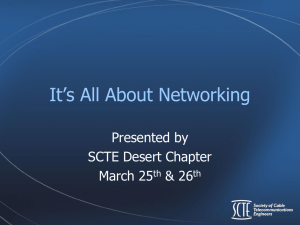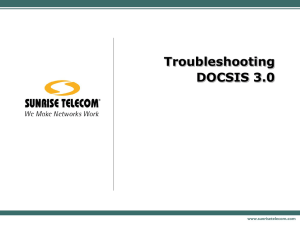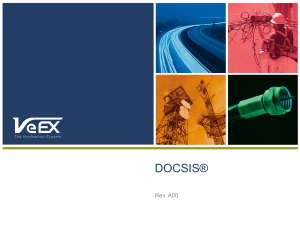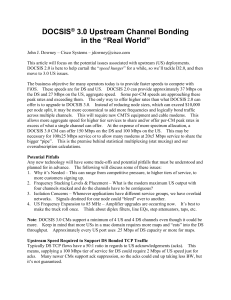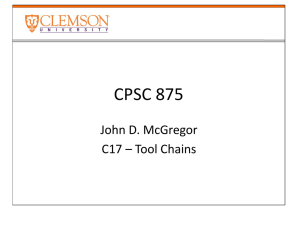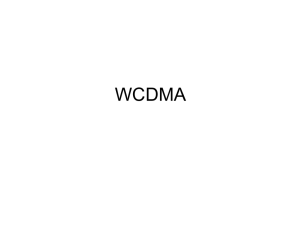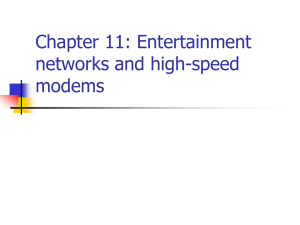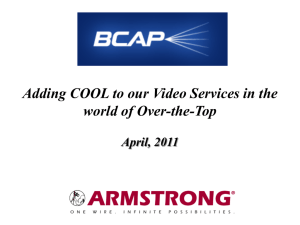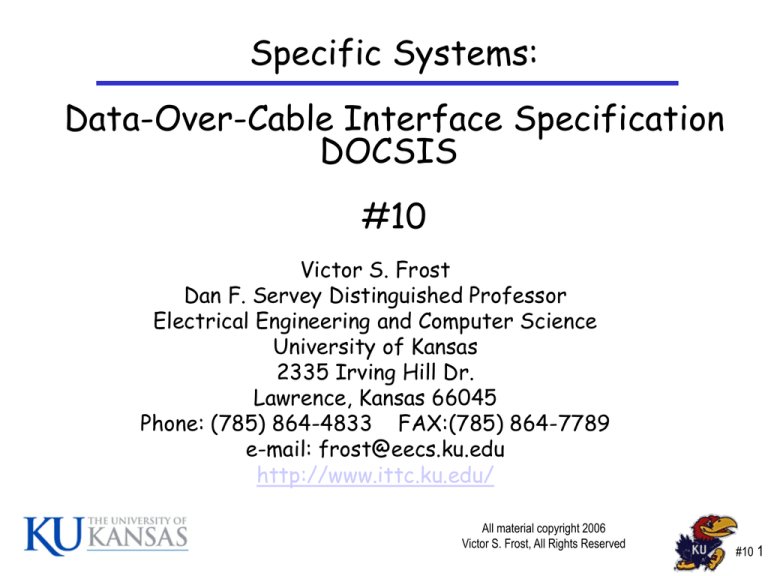
Specific Systems:
Data-Over-Cable Interface Specification
DOCSIS
#10
Victor S. Frost
Dan F. Servey Distinguished Professor
Electrical Engineering and Computer Science
University of Kansas
2335 Irving Hill Dr.
Lawrence, Kansas 66045
Phone: (785) 864-4833 FAX:(785) 864-7789
e-mail: frost@eecs.ku.edu
http://www.ittc.ku.edu/
All material copyright 2006
Victor S. Frost, All Rights Reserved
#10 1
Outline
• DOCSIS Overview
• Protocol Stack
• MAC
–
–
–
–
Timing issues
Packet formats
Access protocol
QoS support
• Evolution
#10 2
Topology and FDM
500 to 2000 homes
Distances up to 100 Km
FDM on the Cable
Modified from: “Computer Networks, 3rd Edition,
A.S. Tanenbaum. Prentice Hall, 1996
#10 3
Some Terminology
•
•
•
•
•
•
•
CMTS: Cable Modem Termination System. Central device for
connecting the cable TV network to a data network like the
internet. Normally placed in the headend of the cable TV system.
Downstream:
Headend: Central distribution point for a CATV system. Video
signals are received here from satellites and maybe other sources,
frequency converted to the appropriate channels, combined with
locally originated signals, and rebroadcast onto the HFC plant.
MSO: Multiple Service Operator. A cable TV service provider that
also provides other services such as data and/or voice telephony.
Upstream: The data flowing from the Cable Modem to the CMTS.
Downstream: The data flowing from the CMTS to the cable modem.
Ranging: The process of automatically adjusting transmit levels and
time offsets of individual modems, in order to make sure the
bursts coming from different modems line up in the right timeslots
and are received at the same power level at the CMTS.
SID (Service ID): Used in the DOCSIS standard to defines a
particular mapping between a cable modem (CM) and the CMTS.
The SID is used for the purpose of upstream bandwidth allocation
and class-of-service management.
#10 4
Data Rates: DOCSIS 1.0/1.1
Carriers limit down and upstream rates, e.g., New Zealand operator TelstraClear
provides:
- downstream speeds of 10Mbit/s and 2Mbit/s
- upstream speed of 2Mbit/s.
#10 5
Issues
• Link management
– Upstream synchronization (timing adjustment)
– Ranging (offset adjustment) (Periodic and Initial)
– Power adjustment
– Burst transmission and reception
• Bandwidth management
–
–
–
–
Bandwidth allocation
Contention resolution
Prioritization/classification of traffic
Supports unsolicited grant service (voice/T1 ckts)
• Subscriber management
– Authentication
– Security
– Registration
Modified from: DOCSIS Overview, Ajay Gummalla,
www.ieee802.org/3/efm/public/jul01/presentations/gummalla_1_0701.pdf
#10 6
DOCSIS Protocol Stack
Convergence Sublayer:
Interface between the MAC layer and
Physical Media Dependent Layer (PMD) or PHY
Can also be Ethernet between the
Host CPE and external CM
NSI=Network
Side Interface
Modified from: www.cablemodem.com/downloads/specs/SP-CMCI-I09-030730.pdf
#10 7
Timing issues
• DOCSIS 1.0/1.1 and 2.0
– Uses burst TDMA system on upstream
– Continuous TDM transmission on the
downstream
• CM must transmit at the “right” time
• CM transmits a Ranging Request (RNGREQ) at initialization
• CMTS responses with a Ranging Response
(RNG-RSP) with timing and to the
information
#10 8
Ranging Process
-Before initial transmission, CM loads it’s ranging offset register with a value to
compensate for the known delays (DS interleaver, implementation delays, etc.)
– The CM the adjusts it’s 32-bit sync counter by the amount in the ranging offset.
– The CM then selects an initial ranging slot and transmits.
– The CMTS measures the difference between the received and expected transmission boundaries
and sends that back to the CM as a ranging adjustment. It also communicates the power level,
frequency offset and delay adjustment to the CM.
From: DOCSIS Overview, Ajay Gummalla,
www.ieee802.org/3/efm/public/jul01/presentations/gummalla_1_0701.pdf
#10 9
CM Initialization
•
•
•
•
•
•
Downstream synchronization for TDM
Obtain upstream parameters
Ranging and automatic adjustments
Establish IP connectivity
Establish time of day
Transfer operational parameters (TFTP
download of configuration parameters)
• Registration
– Assigns a Service ID (SID)
• Baseline privacy initialization
From: DOCSIS Overview, Ajay Gummalla,
www.ieee802.org/3/efm/public/jul01/presentations/gummalla_1_0701.pdf
#10 10
DOCSIS Packets
•
•
•
Downstream DOSCIS Frame Format
Enables TDM of digital video (MPEG frames) and the data frames
(DOCSIS)
Payload
– MGEG Video
– Data
MCNS=Multimedia Cable Network System
From: http://www.nextgendc.com/index.htm
#10 11
DOCSIS Packets
• Upstream format
– Variable length (18-1518 Bytes)
compatible with Ethernet frames
– ATM (53 Bytes) fixed length
– MAC specific, i. e., control
– Reserved
#10 12
Upstream format
• Example
From: http://www.nextgendc.com/index.htm
#10 13
DOCSIS Segmentation
Convergence Layer
From: http://www.jlsnet.co.uk/index.php?tab=3&page=projects_docsis_chap3c
#10 14
How do CM request opportunities to
transmit?
• Upstream channel is divided into stream of TDM
“mini slots”
• Each “minislot” is the unit of granularity for
upstream opportunities to transmit
• Minislots
– Must be multiples of 6.25 us
– Typically 8 to 32 Bytes
• CM will get assigned a group of minislots to
transmit packets,
– Match to transmit opportunity to the packet to be
transmitted
– Increases upstream efficiency
#10 15
How do CM request opportunities to
transmit?
• Each mini slot is assigned a minislot number (wraps
around)
• Ranging is used so all CM and the CMTS have
common view of the minislots
• The CMTS send a variable length Bandwidth
Allocation Map (MAP) message downstream that
identifies
– Describes the permitted use of the upstream channel
– Specific CM with timing for grants to transmit if the
next MAP time interval
– Opportunities for CM’s to request opportunities to
transmit
– System overhead
#10 16
How do CM request opportunities to
transmit?
• Conceptual view of MAP allocation
#10 17
How do CM request opportunities to
transmit?
• Timing of MAP messages and CM
opportunities to transmit
CMTS
t1
CMTS transmits
MAP1 all CM hear this
CM
#10 18
How do CM request opportunities to
transmit?
• Timing of MAP messages and CM
opportunities to transmit
CMTS
t1
CMTS transmits
MAP1 all CM hear this
CM
t2
CMi receives MAP1 looks for request opportunities
#10 19
How do CM request opportunities to
transmit?
• Timing of MAP messages and CM
opportunities to transmit
CMTS
t1
Transmissions based on
MAP1 start
t3
Time for all CM’s to
Receive and process MAP
CM
t2
#10 20
How do CM request opportunities to
transmit?
• Timing of MAP messages and CM
opportunities to transmit
CMTS
CM
t1
Transmissions based on
MAP1 start
t5
t3
- CM transmits a request for
a specific number of minislots
to accommodate a packet
-This is transmitted in contention
minislots
-Contention algorithm later
- t4 selected so that request will be received at t5
t2
t4
#10 21
How do CM request opportunities to
transmit?
• Timing of MAP messages and CM
opportunities to transmit
CMTS
t1
Transmissions based on
MAP1 start
t5
t3
- t5 the CMTS can schedule the
upstream transmissions to satisfy the request
CM
t2
t4
#10 22
How do CM request opportunities to
transmit?
• Timing of MAP messages and CM
opportunities to transmit
CMTS
t1
Transmissions based on
MAP1 start
t5
t3
t6
At t6 CMTS transmits
MAP2 all CM hear this
CM
t2
t4
t7
#10 23
How do CM request opportunities to
transmit?
• Timing of MAP messages and CM
opportunities to transmit
CMTS
CM
t1
Transmissions based on
MAP1 start
t5
t3
t2
t4
t6
Transmissions based on
MAP2 start
t8
t7
#10 24
How do CM request opportunities to
transmit?
• Timing of MAP messages and CM
opportunities to transmit
CMTS
CM
t1
t5
t3
t2
t4
Transmissions of minislot from CM
scheduled to be received
t6
t8
t10
t7
#10 25
How do CM request opportunities to
transmit?
• Timing of MAP messages and CM
opportunities to transmit
CMTS
t1
t5
t3
t6
t8
t10
Transmissions of
minislot from CM
CM
t2
t4
t7
t9
#10 26
Minislots and MAP messges
Minislot numbers
Minislot with identification of Regions
Contention Minislots
Grant for CM20 Offset=5
MAP Information
Upstream Channel ID
MAP start time = 1099
ACK time=0800
Request Region Offset=0
Grant for CM20 Offset=5
Grant for CM90 Offset=9
Null Offset=19
Grant for CM90 Offset=9
#10 27
Contention of bandwidth requests
• Unallocated minislots can be
designated for request (contention)
minislots
• All upstream CM gain access to a
request mini slots using a random
access protocol
#10 28
Contention of bandwidth requests
• Operation of the access protocol
– The CMTS sets
• Initial backoff window Wi
• Maximum backoff Wm
– Packet arrives at CM for transmission
– CM calculates # minislots (including
overhead) needed to send the packet.
– Let R= number of contention minislots to
skip before sending the request
#10 29
Contention of bandwidth requests
• Send the request at minislot R
• k= number of collisions
max(Wi k 1,Wm )
N 2
R U (0, N )
1
• If request not received, i.e., no
minislot allocations in the next MAP
message the k=k+1 and retry
• Maximum backoff attempt = 16
#10 30
Contention of bandwidth requests
• Example
– Let initial backoff window Wi = 4
• Range = 0…15
– Let maximum backoff Wm=10
–
–
–
–
–
• Range = 0…1023
A packet arrives
R = 11
Next MAP has 6 contention slots 6<11 so keep waiting
Next MAP has 2 contention slots 8<11 so keep waiting
Next Map has 8 contention slots so wait 3 minislots and
transmit request
– If no Data Grant (or Data Ack) the assume a collision and
repeat
– Quit after 16 collisions
#10 31
DOCSIS Bandwidth Request PDU Format
*
IE = Information Element
IEs define
-individual grants
-14 bit SID
-4 bit IUC
-14 bit minislot offset
*From: An Investigation into HFC MAC Protocols:
Mechanisms, Implementation, and Research Issues
Ying-Dar Lin, Wei-Ming Yin, and Chen-Yu Huang, National Chiao Tung,
IEEE Communications Survey and Tutorials
#10 32
Increasing the Efficiency of Bandwidth
Requests
• Piggybacked
– Request for future grants for upstream
transmissions can be made in current upstream
data transmissions
– No contention
• Concatenated requests
– Allows more than one packet per transmission
opportunity
– CMTS receiving a MAC packet with
Concatenation MAC header much unpack the
packets.
– This process uses up the header so
piggybacking request is not possible
#10 33
QoS
• QoS is provided by the CMTS
– scheduling upstream transmission via the MAP
– Scheduling downstream transmission
• QoS is provided on an Service ID (SID) basis
*
*From: An Investigation into HFC MAC Protocols:
Mechanisms, Implementation, and Research Issues
Ying-Dar Lin, Wei-Ming Yin, and Chen-Yu Huang, National Chiao Tung,
IEEE Communications Survey and Tutorials
#10 34
QoS
*From: An Investigation into HFC MAC Protocols:
Mechanisms, Implementation, and Research Issues
Ying-Dar Lin, Wei-Ming Yin, and Chen-Yu Huang, National Chiao Tung,
IEEE Communications Survey and Tutorials
#10 35
Best Effort DOCSIS 1.0
From: Data Over Cable Service Interface
Specifications (DOCSIS) Manish Mangal, Sprint, TP&I
#10 36
DOCSIS 1.1 Real Time Polling Mode
From: Data Over Cable Service Interface
Specifications (DOCSIS) Manish Mangal, Sprint, TP&I
#10 37
DOCSIS MAC -- DOCSIS 1.1
Circuit Switched Emulation “Unsolicited Grant Mode”
From: Data Over Cable Service Interface
Specifications (DOCSIS) Manish Mangal, Sprint, TP&I
#10 38
DOCSIS QoS Services
An Investigation into HFC MAC Protocols:
Mechanisms, Implementation, and Research Issues
Ying-Dar Lin, Wei-Ming Yin, and Chen-Yu Huang, National Chiao Tung,
IEEE Communications Survey and Tutorials
#10 39
Access algorithm
An Investigation into HFC MAC Protocols:
Mechanisms, Implementation, and Research Issues
Ying-Dar Lin, Wei-Ming Yin, and Chen-Yu Huang, National Chiao Tung,
IEEE Communications Survey and Tutorials
#10 40
Security- Baseline Privacy
• Two component protocols:
– Encapsulation protocol for encrypting packet data across the
cable network
– BPKM (Baseline Privacy Key Management) protocol for providing
secure distribution of keying material from the CMTS to CM
• Encapsulation protocol defines
– the frame format for carrying encrypted data within DOCSIS
MAC frames
– set of supported cryptographic suites (pairings of data
encryption and authentication algorithms)
– rules for applying these algorithms to a DOCSIS frame’s packet
data
• DOCSIS frame header is not encrypted to facilitate
registration, ranging and normal operation of the DOCSIS
MAC sublayer
• Ref:
– http://www.cablemodem.com/Security_in_DOCSIS.pdf
– BPI has been enhanced in DOCSIS1.1 to add authentication and
Multicast support. http://www.cablemodem.com/BPI+_I06001215.pdf
From: DOCSIS Overview, Ajay Gummalla,
www.ieee802.org/3/efm/public/jul01/presentations/gummalla_1_0701.pdf
#10 41
Evolution of DOCSIS
• DOCSIS 1.0: specifications include technology
that was available in the 1995–1996 timeframe,
and have become very widely deployed around the
world.
– Internet access
• DOCSIS 1.1: specifications provide improved
operational flexibility, security, and Quality-ofService (QoS) features that enable real-time
services.
– Telephony,
– Gaming,
– Streaming Media
• DOCSIS 2.0: specifications provide dramatically
increased upstream throughput for symmetric
services.
Modified from: http://www.cablemodem.com/primer/
#10 42
DOCSIS 1.1 Overview
• Interoperable with DOCSIS 1.0, plus more…
– Access to bandwidth at high data rates or lower latency
adds more value
• Enhanced “Quality of Service” (QoS)
– Guarantees and/or limits for data rates
– Guarantees for latency
• Improved security - designed to reduce possibility
of “theft of service, provide secure software
downloading.”
• Interoperability - DOCSIS 1.0 and DOCSIS 1.1
cable modems and CMTSs on the same plant.
Better operation and OSS features
• Transmit Equalization - more robust transmission
Modified from:http://www.cablemodem.com/primer/
#10 43
DOCSIS 2.0 Overview
(100% backward compatible with DOCSIS 1.0/1.1)
• Symmetrical services are enabled by DOCSIS 2.0
– 1.5x greater efficiency
• operates at 64 QAM
– 2x wider channels
• new 6.4 MHz wide channel
• DOCSIS 2.0 widens the pipe for IP traffic, allowing
cable providers to create more and better services
for voice, video, and data
• It does this by using enhanced modulation and
improved error correction
• Superior ingress and impulse noise performance
Up to 3x better upstream performance than DOCSIS 1.1
Up to 6x better upstream performance than DOCSIS 1.0
Modified from:http://www.cablemodem.com/primer/
#10 44
Evolution of DOCSIS
• DOCSIS 3.0: specifications are
currently in development at CableLabs
and will include a number of
enhancements, most notably, channel
bonding and support for IPv6. Channel
bonding provides cable operators with
a flexible way to increase upstream
and downstream throughput to
customers, with data rates in the
hundreds of megabits and potentially
gigabits per second.
#10 45
The DOCSIS Roadmap
DOCSIS Version
DOCSIS 1.0
DOCSIS 1.1
DOCSIS 2.0
DOCSIS 3.0
X
X
X
X
X
X
X
X
X
X
X
X
X
X
X
X
X
X
X
X
X
X
X
X
X
X
X
X
X
Services
Broadband Internet
Tiered Services
VoIP
Video Conferencing
Commercial Services
Entertainment Video
Consumer Devices
Cable Modem
VoIP Phone (MTA)
Residential Gateway
Video Phone
Mobile Devices
IP Set-top Box
Modified from:http://www.cablemodem.com/primer/
#10 46
Evolution of DOCSIS
• Embedded DOCSIS: eDOCSIS device
contains
– CM
– One or more embedded
Service/Application Functional Entities
(eSAFEs)
• Telephone
• Video
• Audio
#10 47
Evolution of DOCSIS
eDOCSIS Referece Model
From: Data-Over-Cable Service Interface Specifications
eDOCSIS™ Specification CM-SP-eDOCSIS-I08-060407
#10 48
References
•
•
•
•
•
•
•
•
•
•
Bartoš, R., C.K. Godsay, and S. Fulton. Experimental Evaluation of DOCSIS 1.1 Upstream
Performance. in Parallel and Distributed Computing and Networks. 2004. Innsbruck,
Austria.
Fellows, D. and D. Jones, DOCSIS cable modem technology. Communications Magazine,
IEEE, 2001. 39(3): p. 202-209.
Hawa, M. and D.W. Petr. Quality of service scheduling in cable and broadband wireless
access systems. in Tenth IEEE International Workshop on Quality of Service, 2002.
2002.
Lin, Y.-D., W.-M. Yin, and C.-Y. Huang, An Investigation into HFC MAC Protocols:
Mechanisms, Implementation, and Research Issues. IEEE Communications Surveys,
2000.
Martin, J. The Impact of the DOCSIS 1.1/2.0 MAC Protocol on TCP. in Second IEEE
Consumer Communications and Networking Conference. 2005. Las Vegas, NV.
Martin, J. and N. Shrivastav. Modeling the DOCSIS 1.1/2.0 MAC Protocol. in
Proceedings of the 2003 International Conference on Computer Communications and
Networks. 2003. Dallas TX.
Shah, N., et al. A tutorial on DOCSIS: protocol and performance models. in
Proceedings of the International Working Conference on Performance Modeling and
Evaluation of Heterogeneous Networks. 2005. Ikley, UK.
Zhenglin, L. and X. Chongyang, An Analytical Model for the Performance of the
DOCSIS CATV Network The Computer Journal 2002. 45(3): p. 278-284.
http://www.cablemodem.com/primer/
Data-Over-Cable Service Interface Specifications eDOCSIS™ Specification CM-SPeDOCSIS-I08-060407
#10 49
References
“Computer Networks, 3rd Edition, A.S.
Tanenbaum. Prentice Hall, 1996
• DOCSIS Overview, Ajay Gummalla,
www.ieee802.org/3/efm/public/jul01/pres
entations/gummalla_1_0701.pdf
• www.cablemodem.com/downloads/specs/SP
-CMCI-I09-030730.pdf
• http://www.nextgendc.com/index.htm
• http://www.jlsnet.co.uk/index.php?tab=3&p
ge=projects_docsis_chap3c
#10 50
References
#10 51


